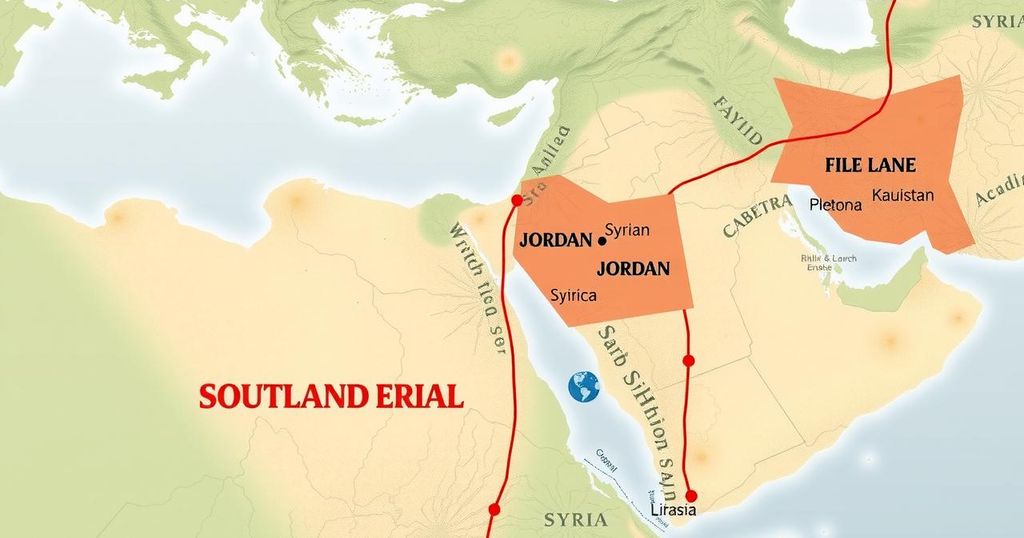Voluntary Land Swaps: A Path to Middle East Stability?
In light of changing geopolitical dynamics, a proposal for voluntary land swaps in the Middle East emerges as a potential key to regional stability. This proposition, particularly for Jordan and Israel, could reshape their defense strategies and economic prospects, given the escalating threats from neighboring regions. Utilizing historical ties and modern negotiations, this strategy aspires to not only enhance security but also promote lasting peace.
The complex borders of the Middle East have long posed challenges for regional stability, but a potential solution has emerged: voluntary land swaps. The convergence of various factors, including the geopolitical climate following the Syrian crisis, the leadership dynamics under U.S. President Donald Trump, and emerging threats to Arab nations from the east, creates a unique opportunity for this type of realignment. This, in particular, could benefit Jordan, which is a critical ally to both Israel and the West.
Jordan’s borders were shaped by colonial decisions in the early 20th century, driven largely by French ambitions in Syria. The British carved out a significant area for the Hashemite dynasty, but today, this arrangement is seen as inadequate, especially given the shifting nature of threats. Historically, Jordan faced danger primarily from Israel, engaging in two major conflicts in the mid-20th century. Now, however, the threats have shifted, with emerging dangers from Iran and other hostile entities encroaching from the north and east.
Recent developments in Jordan have underscored the urgency of this situation. With the rapid changes in Syria and Turkey’s renewed regional ambitions, Jordan finds itself at a crossroads. Formerly shielded by its geography, the kingdom is now vulnerable to a variety of risks, including ISIS, al-Qaeda, and Iranian proxies. This landscape has led analysts to suggest that Jordan must redefine its boundaries for a stronger defense.
Considering a land swap could greatly enhance Jordan’s security posture. By trading its seemingly insignificant western border for a strategic foothold in southern Syria, Jordan would not only bolster its territorial integrity but also take steps towards economic revitalization and restoring its stature as a regional leader. This shift would situate Jordan to exploit historical connections to southern Syria, rekindling a sense of national pride.
On the other side, Israel’s situation is equally pressing. The notion that the Jordan River serves as a dependable barrier has been challenged, especially after recent military actions in Gaza highlighted the need for stronger defensive perimeters. It becomes glaringly apparent that Israel cannot rely solely on its current borders when faced with organized military threats. The risk of an attack from the Jordan River is amplified by the political and military instability gripping the region.
The question of moving Israel’s defensive line further east has circulated among military strategists for years, but a land swap may present the most pragmatic solution. Such an arrangement could allow Jordanian and Israeli forces to collaborate more directly while neutralizing the numerous threats knockings at Jordan’s door. The presence of Israeli forces in Jordan could serve as a major deterrent for would-be aggressors.
Moreover, this potential land swap could serve to stabilize not just Jordan and Israel, but the entire region. Envisioning economic projects, such as the revival of the Syrian desert, provides a clear opportunity for transformative growth. Constructed in tandem with labor solutions and international support, this represents a chance to establish lasting peace.
Crucially, this land swap would not necessitate any shifts in population or citizenship, allowing both Syrian and Jordanian citizens to remain in their homes. The benefits would be mutual, fostering economic ties and enhancing security. Interestingly, even pro-Palestinian factions might find merit in supporting this arrangement, as it could alleviate tensions around the West Bank by providing a buffer for Israel amid calls for Palestinian statehood.
However, substantial opposition to such strategies remains. As discussed in previous writings, the rise of neo-Palestinian ideologies poses new challenges for U.S. national security and global peace efforts. Thus, any discussion of land swaps must take place out of the public eye, handled with sensitivity by strong leaders capable of negotiating practical agreements.
There exists the right leadership now to undertake these discussions—spearheaded by figures like President Trump, whose relationships with Arab leaders could facilitate this crucial dialogue for peace. With the right resources and strategy, it might be possible to transcend decades-old conflicts toward mutually beneficial goals that stabilize the region and lay the groundwork for future prosperity.
In essence, a voluntary land swap could represent a significant step toward stabilizing the tumultuous landscape of the Middle East. For Jordan, it provides an opportunity to secure its borders and reclaim its historical priorities. For Israel, a stronger defense against external threats could be established. Thus, with the right leadership and vision, this could lead towards a peace that is sustainable and beneficial to all parties involved in this complex geopolitical scenario.
Original Source: www.jpost.com




Post Comment